International Business Plan for Volkswagen: Market Entry into India
VerifiedAdded on 2021/02/20
|27
|5786
|234
Report
AI Summary
This comprehensive international business plan focuses on Volkswagen's expansion into the Indian market. The report begins with an introduction to the company and its product, the Volkswagen car, followed by an analysis of the automotive industry, including market size, growth, and trends. It then presents Volkswagen's annual report data. The main body includes a SWOT analysis, PESTLE analysis, and an examination of Porter's Five Forces, the Ansoff Matrix, and SMART objectives. The plan also covers the style of entry into the market and concludes with references and appendices. The plan highlights Volkswagen's strengths, weaknesses, opportunities, and threats within the Indian market, providing a strategic framework for successful international expansion. The document is designed to aid students with similar assignments, and provides detailed insights into international business planning.
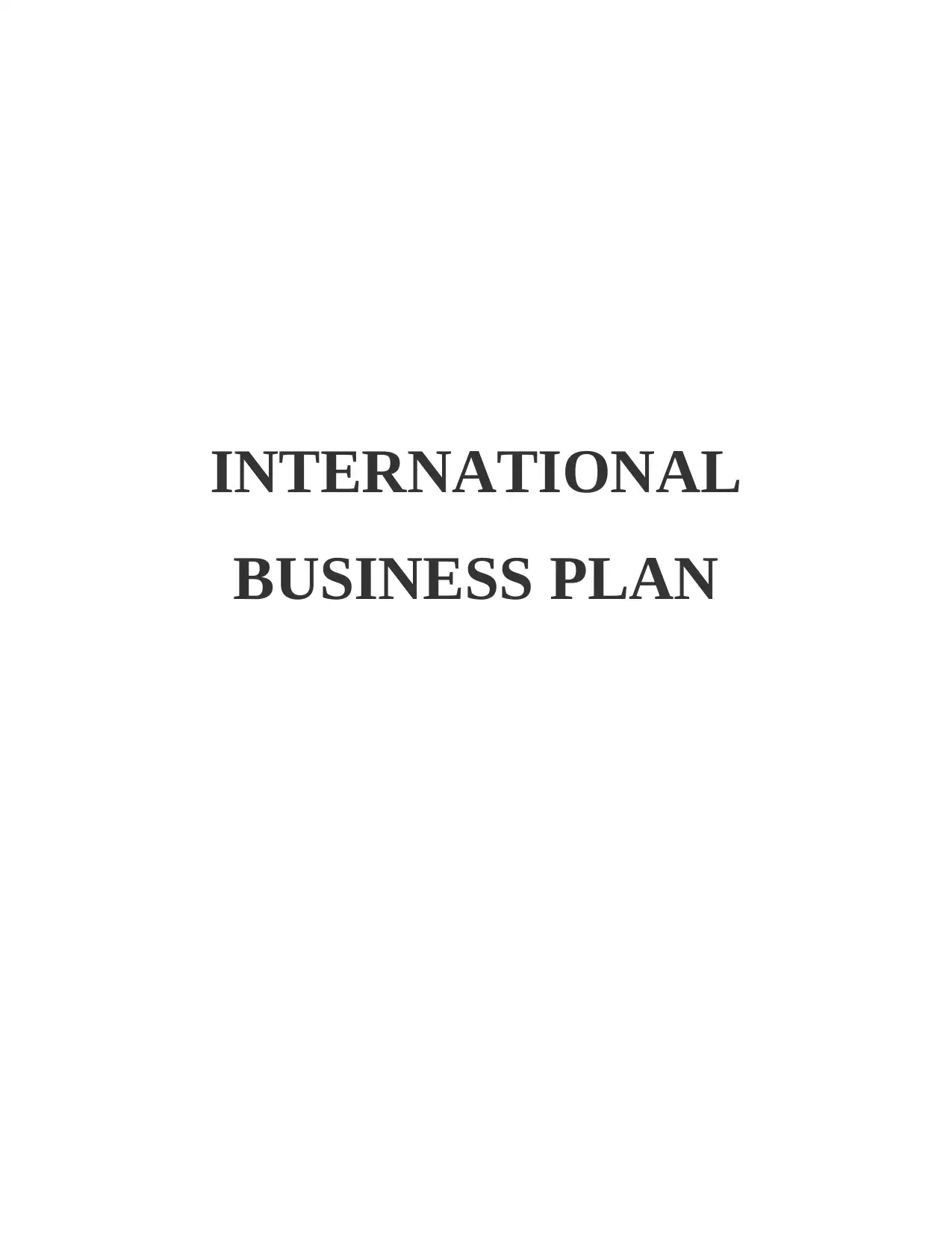
INTERNATIONAL
BUSINESS PLAN
BUSINESS PLAN
Paraphrase This Document
Need a fresh take? Get an instant paraphrase of this document with our AI Paraphraser
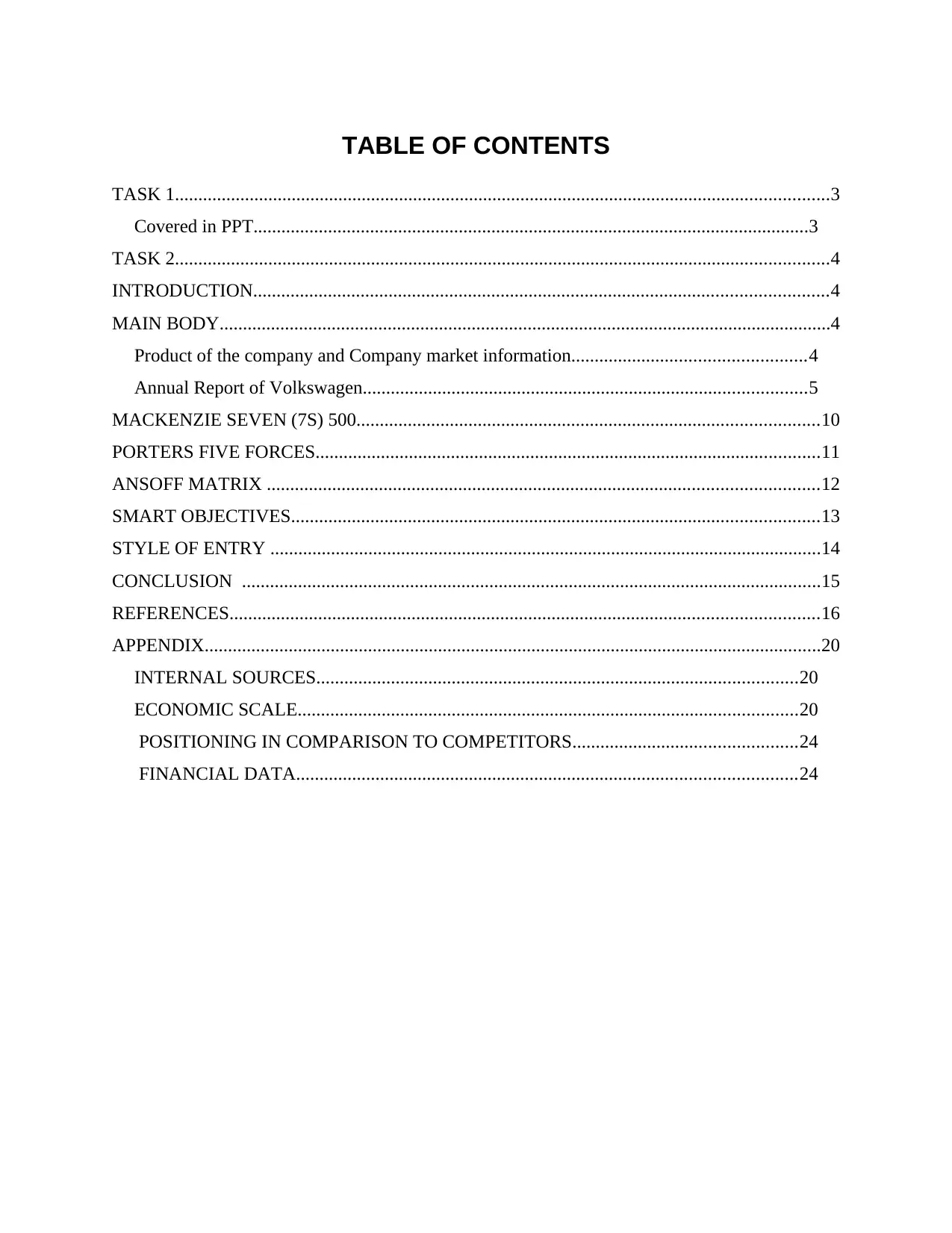
TABLE OF CONTENTS
TASK 1............................................................................................................................................3
Covered in PPT.......................................................................................................................3
TASK 2............................................................................................................................................4
INTRODUCTION...........................................................................................................................4
MAIN BODY...................................................................................................................................4
Product of the company and Company market information..................................................4
Annual Report of Volkswagen...............................................................................................5
MACKENZIE SEVEN (7S) 500...................................................................................................10
PORTERS FIVE FORCES............................................................................................................11
ANSOFF MATRIX ......................................................................................................................12
SMART OBJECTIVES.................................................................................................................13
STYLE OF ENTRY ......................................................................................................................14
CONCLUSION ............................................................................................................................15
REFERENCES..............................................................................................................................16
APPENDIX....................................................................................................................................20
INTERNAL SOURCES.......................................................................................................20
ECONOMIC SCALE...........................................................................................................20
POSITIONING IN COMPARISON TO COMPETITORS................................................24
FINANCIAL DATA...........................................................................................................24
TASK 1............................................................................................................................................3
Covered in PPT.......................................................................................................................3
TASK 2............................................................................................................................................4
INTRODUCTION...........................................................................................................................4
MAIN BODY...................................................................................................................................4
Product of the company and Company market information..................................................4
Annual Report of Volkswagen...............................................................................................5
MACKENZIE SEVEN (7S) 500...................................................................................................10
PORTERS FIVE FORCES............................................................................................................11
ANSOFF MATRIX ......................................................................................................................12
SMART OBJECTIVES.................................................................................................................13
STYLE OF ENTRY ......................................................................................................................14
CONCLUSION ............................................................................................................................15
REFERENCES..............................................................................................................................16
APPENDIX....................................................................................................................................20
INTERNAL SOURCES.......................................................................................................20
ECONOMIC SCALE...........................................................................................................20
POSITIONING IN COMPARISON TO COMPETITORS................................................24
FINANCIAL DATA...........................................................................................................24
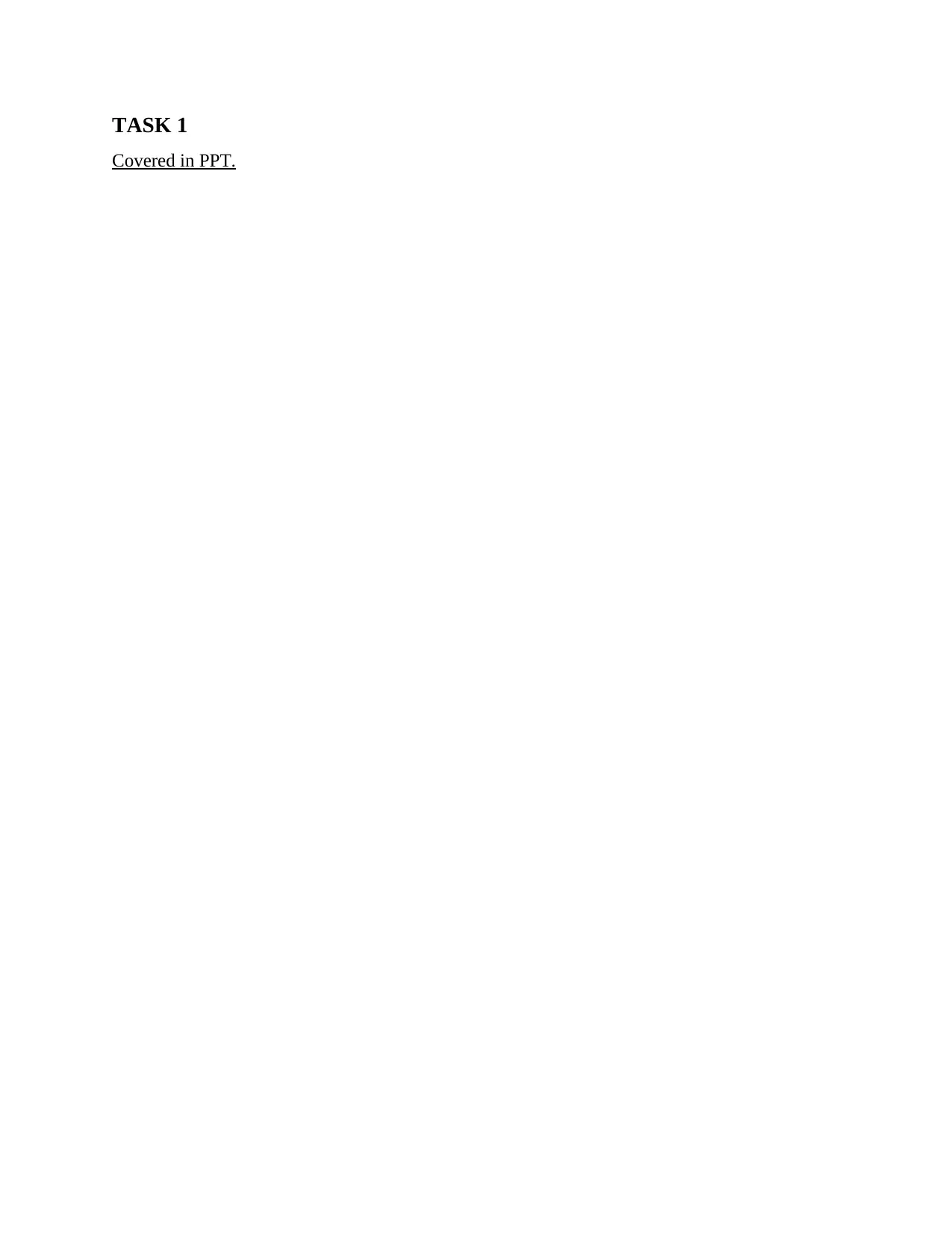
TASK 1
Covered in PPT.
Covered in PPT.
⊘ This is a preview!⊘
Do you want full access?
Subscribe today to unlock all pages.

Trusted by 1+ million students worldwide
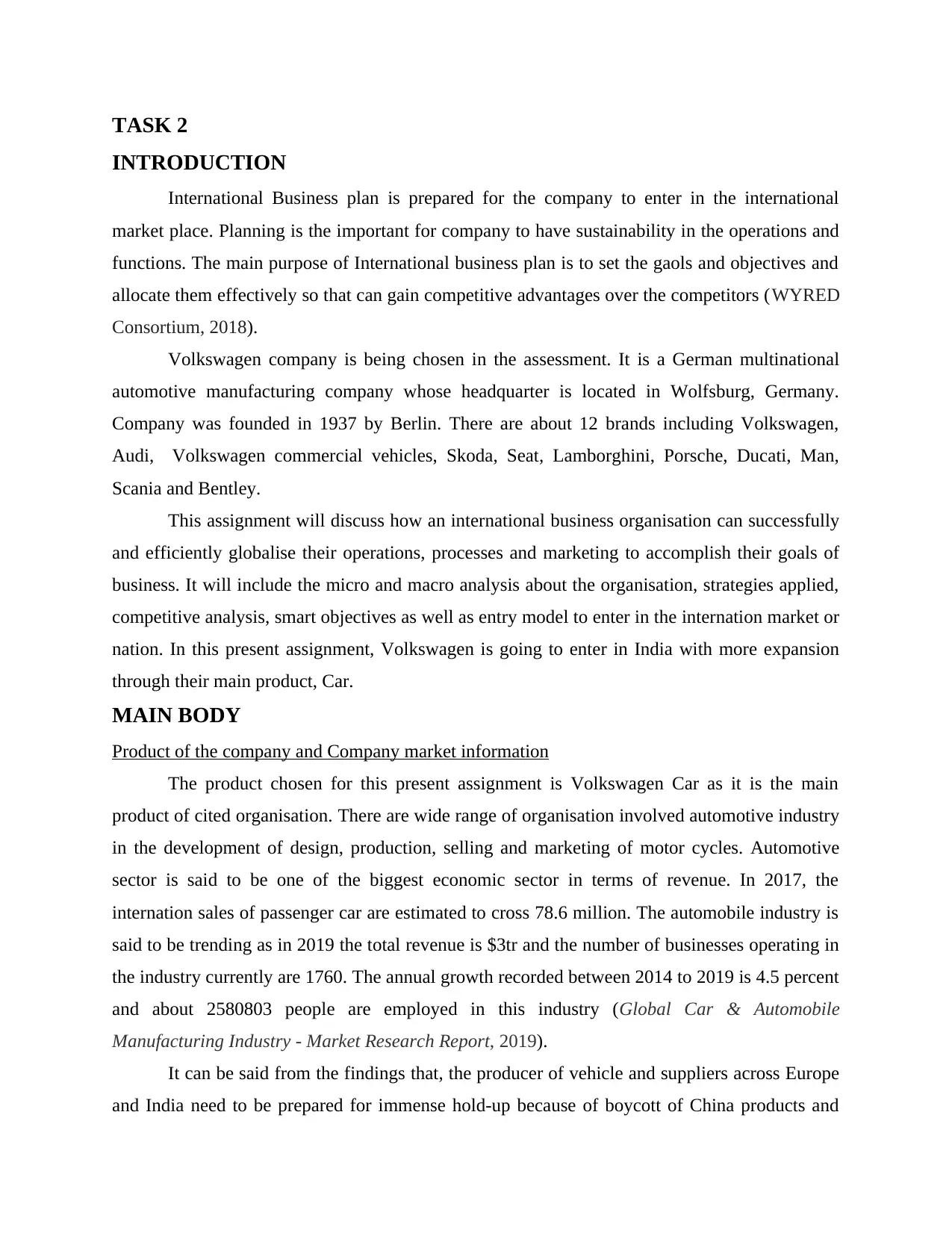
TASK 2
INTRODUCTION
International Business plan is prepared for the company to enter in the international
market place. Planning is the important for company to have sustainability in the operations and
functions. The main purpose of International business plan is to set the gaols and objectives and
allocate them effectively so that can gain competitive advantages over the competitors (WYRED
Consortium, 2018).
Volkswagen company is being chosen in the assessment. It is a German multinational
automotive manufacturing company whose headquarter is located in Wolfsburg, Germany.
Company was founded in 1937 by Berlin. There are about 12 brands including Volkswagen,
Audi, Volkswagen commercial vehicles, Skoda, Seat, Lamborghini, Porsche, Ducati, Man,
Scania and Bentley.
This assignment will discuss how an international business organisation can successfully
and efficiently globalise their operations, processes and marketing to accomplish their goals of
business. It will include the micro and macro analysis about the organisation, strategies applied,
competitive analysis, smart objectives as well as entry model to enter in the internation market or
nation. In this present assignment, Volkswagen is going to enter in India with more expansion
through their main product, Car.
MAIN BODY
Product of the company and Company market information
The product chosen for this present assignment is Volkswagen Car as it is the main
product of cited organisation. There are wide range of organisation involved automotive industry
in the development of design, production, selling and marketing of motor cycles. Automotive
sector is said to be one of the biggest economic sector in terms of revenue. In 2017, the
internation sales of passenger car are estimated to cross 78.6 million. The automobile industry is
said to be trending as in 2019 the total revenue is $3tr and the number of businesses operating in
the industry currently are 1760. The annual growth recorded between 2014 to 2019 is 4.5 percent
and about 2580803 people are employed in this industry (Global Car & Automobile
Manufacturing Industry - Market Research Report, 2019).
It can be said from the findings that, the producer of vehicle and suppliers across Europe
and India need to be prepared for immense hold-up because of boycott of China products and
INTRODUCTION
International Business plan is prepared for the company to enter in the international
market place. Planning is the important for company to have sustainability in the operations and
functions. The main purpose of International business plan is to set the gaols and objectives and
allocate them effectively so that can gain competitive advantages over the competitors (WYRED
Consortium, 2018).
Volkswagen company is being chosen in the assessment. It is a German multinational
automotive manufacturing company whose headquarter is located in Wolfsburg, Germany.
Company was founded in 1937 by Berlin. There are about 12 brands including Volkswagen,
Audi, Volkswagen commercial vehicles, Skoda, Seat, Lamborghini, Porsche, Ducati, Man,
Scania and Bentley.
This assignment will discuss how an international business organisation can successfully
and efficiently globalise their operations, processes and marketing to accomplish their goals of
business. It will include the micro and macro analysis about the organisation, strategies applied,
competitive analysis, smart objectives as well as entry model to enter in the internation market or
nation. In this present assignment, Volkswagen is going to enter in India with more expansion
through their main product, Car.
MAIN BODY
Product of the company and Company market information
The product chosen for this present assignment is Volkswagen Car as it is the main
product of cited organisation. There are wide range of organisation involved automotive industry
in the development of design, production, selling and marketing of motor cycles. Automotive
sector is said to be one of the biggest economic sector in terms of revenue. In 2017, the
internation sales of passenger car are estimated to cross 78.6 million. The automobile industry is
said to be trending as in 2019 the total revenue is $3tr and the number of businesses operating in
the industry currently are 1760. The annual growth recorded between 2014 to 2019 is 4.5 percent
and about 2580803 people are employed in this industry (Global Car & Automobile
Manufacturing Industry - Market Research Report, 2019).
It can be said from the findings that, the producer of vehicle and suppliers across Europe
and India need to be prepared for immense hold-up because of boycott of China products and
Paraphrase This Document
Need a fresh take? Get an instant paraphrase of this document with our AI Paraphraser
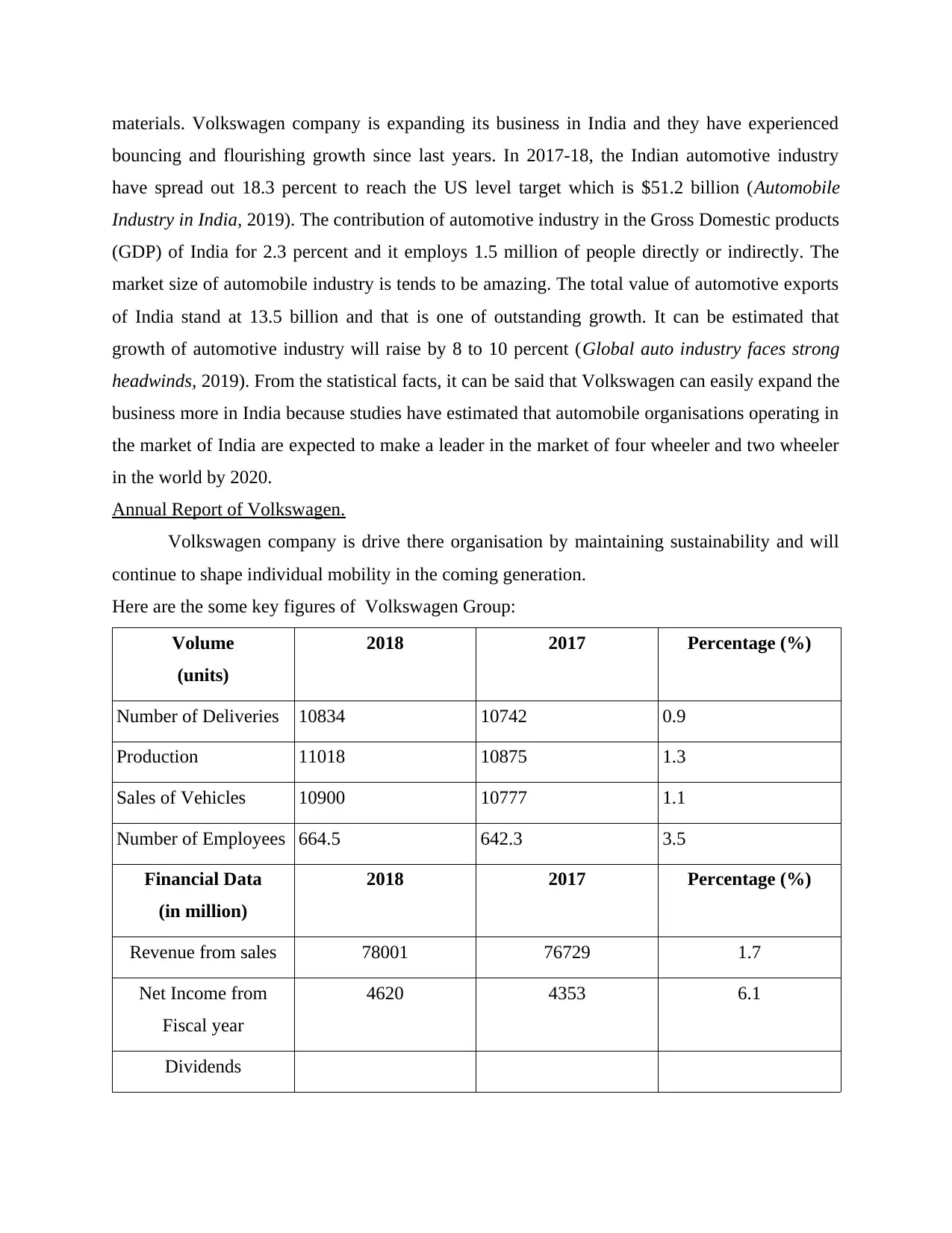
materials. Volkswagen company is expanding its business in India and they have experienced
bouncing and flourishing growth since last years. In 2017-18, the Indian automotive industry
have spread out 18.3 percent to reach the US level target which is $51.2 billion (Automobile
Industry in India, 2019). The contribution of automotive industry in the Gross Domestic products
(GDP) of India for 2.3 percent and it employs 1.5 million of people directly or indirectly. The
market size of automobile industry is tends to be amazing. The total value of automotive exports
of India stand at 13.5 billion and that is one of outstanding growth. It can be estimated that
growth of automotive industry will raise by 8 to 10 percent (Global auto industry faces strong
headwinds, 2019). From the statistical facts, it can be said that Volkswagen can easily expand the
business more in India because studies have estimated that automobile organisations operating in
the market of India are expected to make a leader in the market of four wheeler and two wheeler
in the world by 2020.
Annual Report of Volkswagen.
Volkswagen company is drive there organisation by maintaining sustainability and will
continue to shape individual mobility in the coming generation.
Here are the some key figures of Volkswagen Group:
Volume
(units)
2018 2017 Percentage (%)
Number of Deliveries 10834 10742 0.9
Production 11018 10875 1.3
Sales of Vehicles 10900 10777 1.1
Number of Employees 664.5 642.3 3.5
Financial Data
(in million)
2018 2017 Percentage (%)
Revenue from sales 78001 76729 1.7
Net Income from
Fiscal year
4620 4353 6.1
Dividends
bouncing and flourishing growth since last years. In 2017-18, the Indian automotive industry
have spread out 18.3 percent to reach the US level target which is $51.2 billion (Automobile
Industry in India, 2019). The contribution of automotive industry in the Gross Domestic products
(GDP) of India for 2.3 percent and it employs 1.5 million of people directly or indirectly. The
market size of automobile industry is tends to be amazing. The total value of automotive exports
of India stand at 13.5 billion and that is one of outstanding growth. It can be estimated that
growth of automotive industry will raise by 8 to 10 percent (Global auto industry faces strong
headwinds, 2019). From the statistical facts, it can be said that Volkswagen can easily expand the
business more in India because studies have estimated that automobile organisations operating in
the market of India are expected to make a leader in the market of four wheeler and two wheeler
in the world by 2020.
Annual Report of Volkswagen.
Volkswagen company is drive there organisation by maintaining sustainability and will
continue to shape individual mobility in the coming generation.
Here are the some key figures of Volkswagen Group:
Volume
(units)
2018 2017 Percentage (%)
Number of Deliveries 10834 10742 0.9
Production 11018 10875 1.3
Sales of Vehicles 10900 10777 1.1
Number of Employees 664.5 642.3 3.5
Financial Data
(in million)
2018 2017 Percentage (%)
Revenue from sales 78001 76729 1.7
Net Income from
Fiscal year
4620 4353 6.1
Dividends
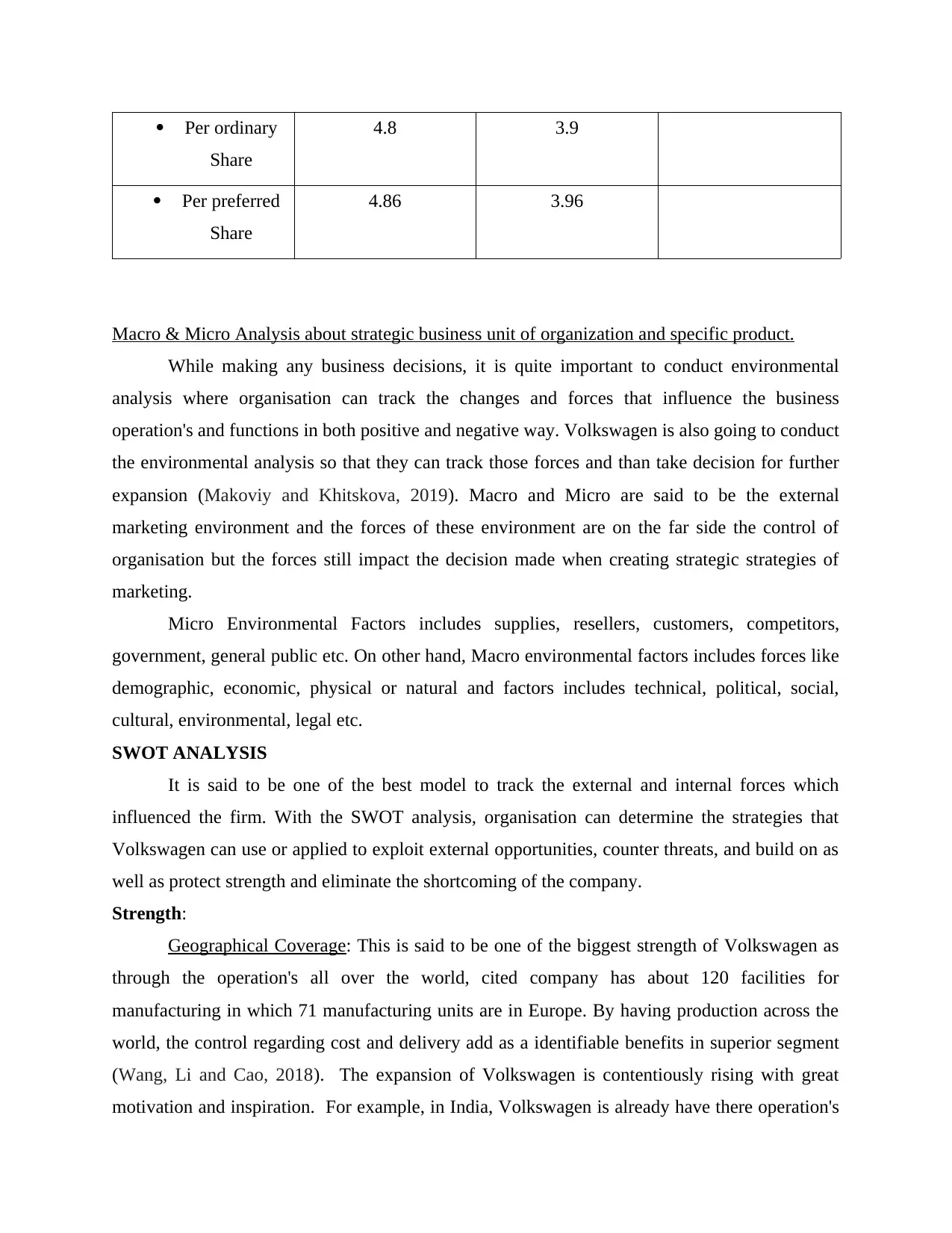
Per ordinary
Share
4.8 3.9
Per preferred
Share
4.86 3.96
Macro & Micro Analysis about strategic business unit of organization and specific product.
While making any business decisions, it is quite important to conduct environmental
analysis where organisation can track the changes and forces that influence the business
operation's and functions in both positive and negative way. Volkswagen is also going to conduct
the environmental analysis so that they can track those forces and than take decision for further
expansion (Makoviy and Khitskova, 2019). Macro and Micro are said to be the external
marketing environment and the forces of these environment are on the far side the control of
organisation but the forces still impact the decision made when creating strategic strategies of
marketing.
Micro Environmental Factors includes supplies, resellers, customers, competitors,
government, general public etc. On other hand, Macro environmental factors includes forces like
demographic, economic, physical or natural and factors includes technical, political, social,
cultural, environmental, legal etc.
SWOT ANALYSIS
It is said to be one of the best model to track the external and internal forces which
influenced the firm. With the SWOT analysis, organisation can determine the strategies that
Volkswagen can use or applied to exploit external opportunities, counter threats, and build on as
well as protect strength and eliminate the shortcoming of the company.
Strength:
Geographical Coverage: This is said to be one of the biggest strength of Volkswagen as
through the operation's all over the world, cited company has about 120 facilities for
manufacturing in which 71 manufacturing units are in Europe. By having production across the
world, the control regarding cost and delivery add as a identifiable benefits in superior segment
(Wang, Li and Cao, 2018). The expansion of Volkswagen is contentiously rising with great
motivation and inspiration. For example, in India, Volkswagen is already have there operation's
Share
4.8 3.9
Per preferred
Share
4.86 3.96
Macro & Micro Analysis about strategic business unit of organization and specific product.
While making any business decisions, it is quite important to conduct environmental
analysis where organisation can track the changes and forces that influence the business
operation's and functions in both positive and negative way. Volkswagen is also going to conduct
the environmental analysis so that they can track those forces and than take decision for further
expansion (Makoviy and Khitskova, 2019). Macro and Micro are said to be the external
marketing environment and the forces of these environment are on the far side the control of
organisation but the forces still impact the decision made when creating strategic strategies of
marketing.
Micro Environmental Factors includes supplies, resellers, customers, competitors,
government, general public etc. On other hand, Macro environmental factors includes forces like
demographic, economic, physical or natural and factors includes technical, political, social,
cultural, environmental, legal etc.
SWOT ANALYSIS
It is said to be one of the best model to track the external and internal forces which
influenced the firm. With the SWOT analysis, organisation can determine the strategies that
Volkswagen can use or applied to exploit external opportunities, counter threats, and build on as
well as protect strength and eliminate the shortcoming of the company.
Strength:
Geographical Coverage: This is said to be one of the biggest strength of Volkswagen as
through the operation's all over the world, cited company has about 120 facilities for
manufacturing in which 71 manufacturing units are in Europe. By having production across the
world, the control regarding cost and delivery add as a identifiable benefits in superior segment
(Wang, Li and Cao, 2018). The expansion of Volkswagen is contentiously rising with great
motivation and inspiration. For example, in India, Volkswagen is already have there operation's
⊘ This is a preview!⊘
Do you want full access?
Subscribe today to unlock all pages.

Trusted by 1+ million students worldwide

but company is planning for more expansion over India to cover maximum amount of market
share.
Audi: Audi is also one of the important part of Volkswagen and it is remarkable as the
strength of the company. The cash of Volkswagen is mainly contributed by Audi car which is
around 27 percent by having sales of 1500 plus. Further, the product portfolio of Volkswagen is
very large in which the passenger car have the highest contribution to the sales of cited
organisation which is approximately 48 percent. With the large product portfolio, Volkswagen
company can easily recover there loss with other products.
Proshce: This is one another premium brands which have joined in 2013 in the
Volkswagen group. This brad is the among the third largest contribution in the sales revenue of
Volkswagen.
Skoda: Skoda is said to be one of the most valuable brand in terms product offering and
brand equity. The acquisition of Skoda was done in 1993.
Bugatti, Lamborghini, Ducatti and Bentley: The abroad brands, which have been
methodically acquired one after the other by Piech are amalgamate into bigger units so few
financial information are render (Grant, 2016).
Weaknesses:
High Dependency on Europe: The sales and profitability of Volkswagen is highly
depending of Europe by which if there is any drop in prices of car due to change in economic
climate has lead to direct impact on the earning.
Volkswagen Brand: In western Europe, Brazil and China company is one of the dominant
player but in United States, India and Russia, company is legging behind of its competitors
(Kreutzer, 2019).
Image and Reputation is negatively affected by diesel scandal: In 2015, the diesel scandal
of Volkswagen has negatively affected the brand image in the market and impact is continued till
2017. Company have to bear million of loss.
Operating Profit is reduced because of rising compliance issue: The operating profit of
Volkswagen had badly affected as they have to billion of fines because of tainted and rotten
vehicles. For example in US, 25 Billions of penalties were paid by Volkswagen.
Opportunities:
share.
Audi: Audi is also one of the important part of Volkswagen and it is remarkable as the
strength of the company. The cash of Volkswagen is mainly contributed by Audi car which is
around 27 percent by having sales of 1500 plus. Further, the product portfolio of Volkswagen is
very large in which the passenger car have the highest contribution to the sales of cited
organisation which is approximately 48 percent. With the large product portfolio, Volkswagen
company can easily recover there loss with other products.
Proshce: This is one another premium brands which have joined in 2013 in the
Volkswagen group. This brad is the among the third largest contribution in the sales revenue of
Volkswagen.
Skoda: Skoda is said to be one of the most valuable brand in terms product offering and
brand equity. The acquisition of Skoda was done in 1993.
Bugatti, Lamborghini, Ducatti and Bentley: The abroad brands, which have been
methodically acquired one after the other by Piech are amalgamate into bigger units so few
financial information are render (Grant, 2016).
Weaknesses:
High Dependency on Europe: The sales and profitability of Volkswagen is highly
depending of Europe by which if there is any drop in prices of car due to change in economic
climate has lead to direct impact on the earning.
Volkswagen Brand: In western Europe, Brazil and China company is one of the dominant
player but in United States, India and Russia, company is legging behind of its competitors
(Kreutzer, 2019).
Image and Reputation is negatively affected by diesel scandal: In 2015, the diesel scandal
of Volkswagen has negatively affected the brand image in the market and impact is continued till
2017. Company have to bear million of loss.
Operating Profit is reduced because of rising compliance issue: The operating profit of
Volkswagen had badly affected as they have to billion of fines because of tainted and rotten
vehicles. For example in US, 25 Billions of penalties were paid by Volkswagen.
Opportunities:
Paraphrase This Document
Need a fresh take? Get an instant paraphrase of this document with our AI Paraphraser

Demands of Passenger cars is rising in Asia Pacific: This is the major opportunity that
Volkswagen have in the market of Asia Pacific. In Asia Pacific, India is one of the biggest
market which are offering vast offering (Zhang and Wang, 2019).
Sustainable Technology: There are huge number of opportunities which are provided by
Sustainability. On the other side from sustainable manufacturing of cars and supply chain,
sustainable innovation is offering intense opportunities for R&D.
Partnership and Restructuring: This is another opportunity that Volkswagen have as they
can make partnership agreement with the companies operating in India like Hyundai, Honda,
Maruti Suzuki etc. In addition to this, there are various issues related to the management, so after
Diesel scandal, VW can set an aspiring plan to improve the health of the business (Wang, Shen
and Zuo, 2019).
Threat:
Heavy Competition: The competition in automotive industry is very high as it is keep
growing high. Not only in particular segment but organisations are facing intense competition in
premium segment from rival brands.
Economic Fluctuation: The sales and profitability of automotive industry is highly
affected by the economic fluctuation. Like in the time of recession, the sales of Volkswagen was
greatly affected (Lin, 2016).
Legal Issues: legal issues are also leading company in great trouble especially in
automotive sector. Recently, Volkswagen has landed itself into major troubles related to
emission.
PESTLE ANALYSIS
Pestle Analysis is one of the best model to track the external factors that impact on the
business profitability, earning, sales and its operations. Volkswagen is going to expand there
business more, so it is all important to analyse the factors to undertake the critical decisions for
the company.
Political Factors:
Political factors include all the government laws, legislation which affect the business in
both positive and negative way. The political stability of India is good where Volkswagen can
make the strategies on the basis of political system of India. Volkswagen can operate its business
more transparently so that possibility of corruption is reduced. Further the regulatory practices
Volkswagen have in the market of Asia Pacific. In Asia Pacific, India is one of the biggest
market which are offering vast offering (Zhang and Wang, 2019).
Sustainable Technology: There are huge number of opportunities which are provided by
Sustainability. On the other side from sustainable manufacturing of cars and supply chain,
sustainable innovation is offering intense opportunities for R&D.
Partnership and Restructuring: This is another opportunity that Volkswagen have as they
can make partnership agreement with the companies operating in India like Hyundai, Honda,
Maruti Suzuki etc. In addition to this, there are various issues related to the management, so after
Diesel scandal, VW can set an aspiring plan to improve the health of the business (Wang, Shen
and Zuo, 2019).
Threat:
Heavy Competition: The competition in automotive industry is very high as it is keep
growing high. Not only in particular segment but organisations are facing intense competition in
premium segment from rival brands.
Economic Fluctuation: The sales and profitability of automotive industry is highly
affected by the economic fluctuation. Like in the time of recession, the sales of Volkswagen was
greatly affected (Lin, 2016).
Legal Issues: legal issues are also leading company in great trouble especially in
automotive sector. Recently, Volkswagen has landed itself into major troubles related to
emission.
PESTLE ANALYSIS
Pestle Analysis is one of the best model to track the external factors that impact on the
business profitability, earning, sales and its operations. Volkswagen is going to expand there
business more, so it is all important to analyse the factors to undertake the critical decisions for
the company.
Political Factors:
Political factors include all the government laws, legislation which affect the business in
both positive and negative way. The political stability of India is good where Volkswagen can
make the strategies on the basis of political system of India. Volkswagen can operate its business
more transparently so that possibility of corruption is reduced. Further the regulatory practices

are also in a streamlined with internation laws that aids nations to improves its ease of doing
business which is also a great opportunity for Volkswagen (Monteiro, 2016). Apart from this,
there are some challenges which organisation can face like they have to keep regular eye on the
changing policies because any thing missed can negative effect on the reputation of the
company.
Economic Factor:
Economic Factors have a direct effect on the business and they do not by affecting
demand. Fluctuations in economic condition in automotive industry have badly affect the sales
and profitability of automotive industry. The government of India has raised the investment in
developing core infrastructure in order to facilitate as well as amend business environment. The
rate of exchange also affect the sales of Volkswagen. Company can raise there performance by 9
top 10 percent due to increasing expenditure of government, rising investment and rising
disposal income. Apart from this, at the time of declining economic power of people in India the
sales of vehicles are badly affected (Trávníčková, 2018).
Social Factor:
Social Forces are also playing increasingly essential role in the growth of business
industry. This includes forces like preference of customers and customer purchasing habits. Like
in India, the demands of passenger cars is very high, so it is better for Volkswagen to
manufacture passenger cars. Company can raise its customer base and sales by manufacturing
car according to the needs and trends of Indians (Kasap and et.al., 2016). Apart from this, people
are also highly preferring products which are sustainable cars and electric cars. So, Volkswagen
can also raise its customer base and sales.
Technological Factor:
The role played by technology is central part in the automobile industry as the success of
brands is depends on how the company is advance in terms of technology. Companies operating
in automobile industry is investing huge amount in R&D just to remain ahead of competitors. In
German Research Centrer for Artificial Intelligence (DFKI), Volkswagen has take on a great
stake. For getting higher satisfaction of customer, Audi is also focussing on innovation. By
taking this as an opportunity, Volkswagen can take an advantage and invest more in
manufacturing highly technical budget (SM, 2018). On the other hand, the rapid change in
business which is also a great opportunity for Volkswagen (Monteiro, 2016). Apart from this,
there are some challenges which organisation can face like they have to keep regular eye on the
changing policies because any thing missed can negative effect on the reputation of the
company.
Economic Factor:
Economic Factors have a direct effect on the business and they do not by affecting
demand. Fluctuations in economic condition in automotive industry have badly affect the sales
and profitability of automotive industry. The government of India has raised the investment in
developing core infrastructure in order to facilitate as well as amend business environment. The
rate of exchange also affect the sales of Volkswagen. Company can raise there performance by 9
top 10 percent due to increasing expenditure of government, rising investment and rising
disposal income. Apart from this, at the time of declining economic power of people in India the
sales of vehicles are badly affected (Trávníčková, 2018).
Social Factor:
Social Forces are also playing increasingly essential role in the growth of business
industry. This includes forces like preference of customers and customer purchasing habits. Like
in India, the demands of passenger cars is very high, so it is better for Volkswagen to
manufacture passenger cars. Company can raise its customer base and sales by manufacturing
car according to the needs and trends of Indians (Kasap and et.al., 2016). Apart from this, people
are also highly preferring products which are sustainable cars and electric cars. So, Volkswagen
can also raise its customer base and sales.
Technological Factor:
The role played by technology is central part in the automobile industry as the success of
brands is depends on how the company is advance in terms of technology. Companies operating
in automobile industry is investing huge amount in R&D just to remain ahead of competitors. In
German Research Centrer for Artificial Intelligence (DFKI), Volkswagen has take on a great
stake. For getting higher satisfaction of customer, Audi is also focussing on innovation. By
taking this as an opportunity, Volkswagen can take an advantage and invest more in
manufacturing highly technical budget (SM, 2018). On the other hand, the rapid change in
⊘ This is a preview!⊘
Do you want full access?
Subscribe today to unlock all pages.

Trusted by 1+ million students worldwide
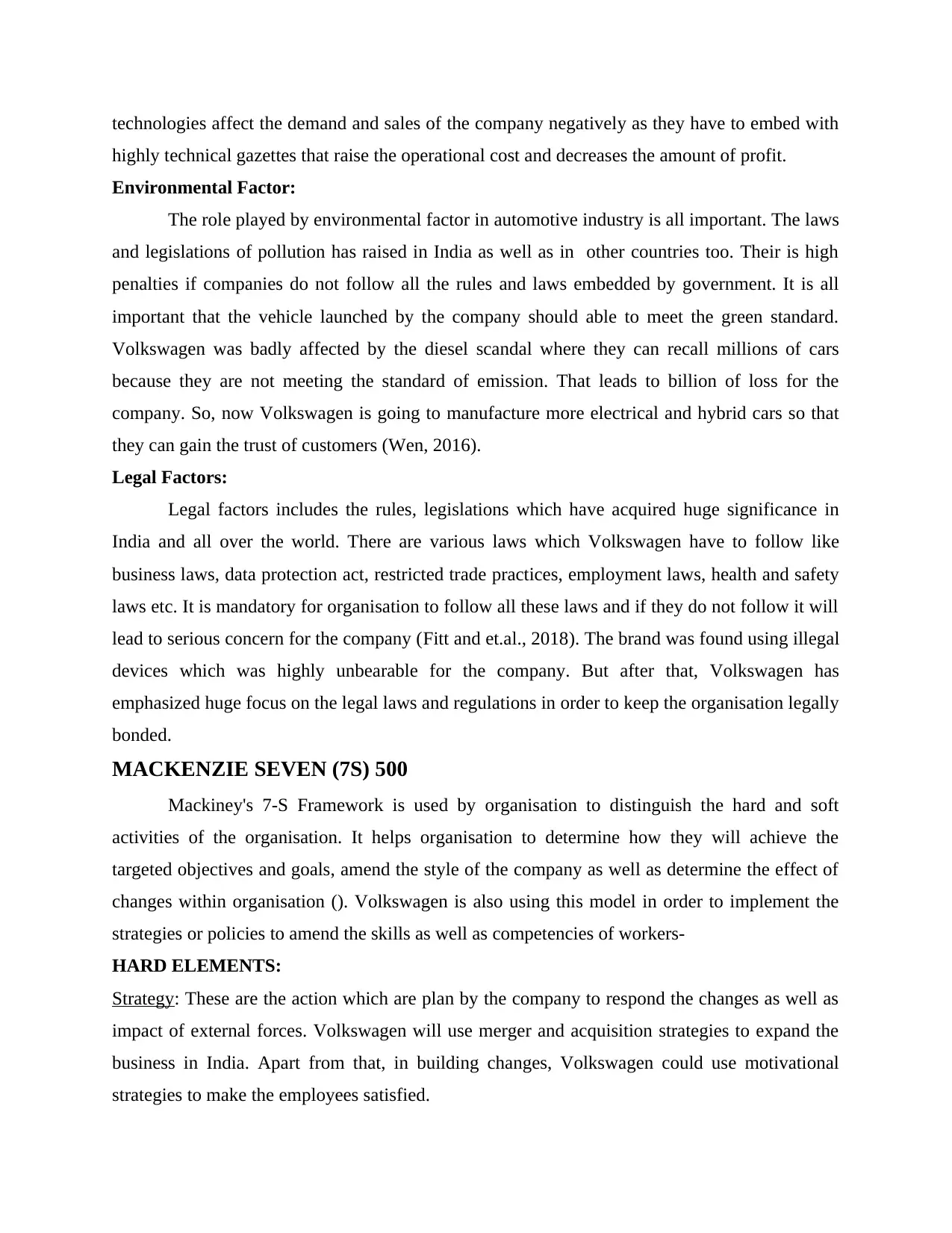
technologies affect the demand and sales of the company negatively as they have to embed with
highly technical gazettes that raise the operational cost and decreases the amount of profit.
Environmental Factor:
The role played by environmental factor in automotive industry is all important. The laws
and legislations of pollution has raised in India as well as in other countries too. Their is high
penalties if companies do not follow all the rules and laws embedded by government. It is all
important that the vehicle launched by the company should able to meet the green standard.
Volkswagen was badly affected by the diesel scandal where they can recall millions of cars
because they are not meeting the standard of emission. That leads to billion of loss for the
company. So, now Volkswagen is going to manufacture more electrical and hybrid cars so that
they can gain the trust of customers (Wen, 2016).
Legal Factors:
Legal factors includes the rules, legislations which have acquired huge significance in
India and all over the world. There are various laws which Volkswagen have to follow like
business laws, data protection act, restricted trade practices, employment laws, health and safety
laws etc. It is mandatory for organisation to follow all these laws and if they do not follow it will
lead to serious concern for the company (Fitt and et.al., 2018). The brand was found using illegal
devices which was highly unbearable for the company. But after that, Volkswagen has
emphasized huge focus on the legal laws and regulations in order to keep the organisation legally
bonded.
MACKENZIE SEVEN (7S) 500
Mackiney's 7-S Framework is used by organisation to distinguish the hard and soft
activities of the organisation. It helps organisation to determine how they will achieve the
targeted objectives and goals, amend the style of the company as well as determine the effect of
changes within organisation (). Volkswagen is also using this model in order to implement the
strategies or policies to amend the skills as well as competencies of workers-
HARD ELEMENTS:
Strategy: These are the action which are plan by the company to respond the changes as well as
impact of external forces. Volkswagen will use merger and acquisition strategies to expand the
business in India. Apart from that, in building changes, Volkswagen could use motivational
strategies to make the employees satisfied.
highly technical gazettes that raise the operational cost and decreases the amount of profit.
Environmental Factor:
The role played by environmental factor in automotive industry is all important. The laws
and legislations of pollution has raised in India as well as in other countries too. Their is high
penalties if companies do not follow all the rules and laws embedded by government. It is all
important that the vehicle launched by the company should able to meet the green standard.
Volkswagen was badly affected by the diesel scandal where they can recall millions of cars
because they are not meeting the standard of emission. That leads to billion of loss for the
company. So, now Volkswagen is going to manufacture more electrical and hybrid cars so that
they can gain the trust of customers (Wen, 2016).
Legal Factors:
Legal factors includes the rules, legislations which have acquired huge significance in
India and all over the world. There are various laws which Volkswagen have to follow like
business laws, data protection act, restricted trade practices, employment laws, health and safety
laws etc. It is mandatory for organisation to follow all these laws and if they do not follow it will
lead to serious concern for the company (Fitt and et.al., 2018). The brand was found using illegal
devices which was highly unbearable for the company. But after that, Volkswagen has
emphasized huge focus on the legal laws and regulations in order to keep the organisation legally
bonded.
MACKENZIE SEVEN (7S) 500
Mackiney's 7-S Framework is used by organisation to distinguish the hard and soft
activities of the organisation. It helps organisation to determine how they will achieve the
targeted objectives and goals, amend the style of the company as well as determine the effect of
changes within organisation (). Volkswagen is also using this model in order to implement the
strategies or policies to amend the skills as well as competencies of workers-
HARD ELEMENTS:
Strategy: These are the action which are plan by the company to respond the changes as well as
impact of external forces. Volkswagen will use merger and acquisition strategies to expand the
business in India. Apart from that, in building changes, Volkswagen could use motivational
strategies to make the employees satisfied.
Paraphrase This Document
Need a fresh take? Get an instant paraphrase of this document with our AI Paraphraser
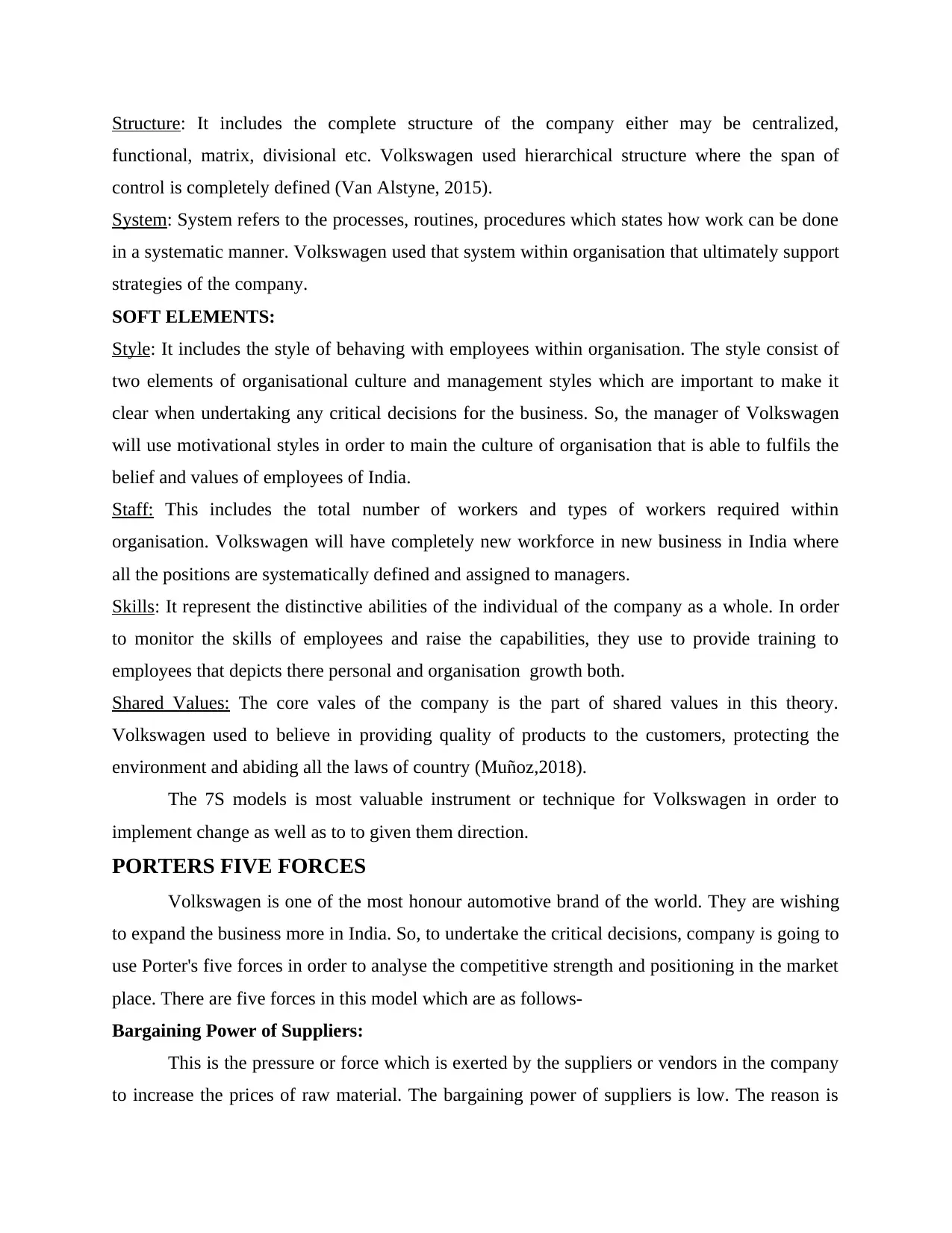
Structure: It includes the complete structure of the company either may be centralized,
functional, matrix, divisional etc. Volkswagen used hierarchical structure where the span of
control is completely defined (Van Alstyne, 2015).
System: System refers to the processes, routines, procedures which states how work can be done
in a systematic manner. Volkswagen used that system within organisation that ultimately support
strategies of the company.
SOFT ELEMENTS:
Style: It includes the style of behaving with employees within organisation. The style consist of
two elements of organisational culture and management styles which are important to make it
clear when undertaking any critical decisions for the business. So, the manager of Volkswagen
will use motivational styles in order to main the culture of organisation that is able to fulfils the
belief and values of employees of India.
Staff: This includes the total number of workers and types of workers required within
organisation. Volkswagen will have completely new workforce in new business in India where
all the positions are systematically defined and assigned to managers.
Skills: It represent the distinctive abilities of the individual of the company as a whole. In order
to monitor the skills of employees and raise the capabilities, they use to provide training to
employees that depicts there personal and organisation growth both.
Shared Values: The core vales of the company is the part of shared values in this theory.
Volkswagen used to believe in providing quality of products to the customers, protecting the
environment and abiding all the laws of country (Muñoz,2018).
The 7S models is most valuable instrument or technique for Volkswagen in order to
implement change as well as to to given them direction.
PORTERS FIVE FORCES
Volkswagen is one of the most honour automotive brand of the world. They are wishing
to expand the business more in India. So, to undertake the critical decisions, company is going to
use Porter's five forces in order to analyse the competitive strength and positioning in the market
place. There are five forces in this model which are as follows-
Bargaining Power of Suppliers:
This is the pressure or force which is exerted by the suppliers or vendors in the company
to increase the prices of raw material. The bargaining power of suppliers is low. The reason is
functional, matrix, divisional etc. Volkswagen used hierarchical structure where the span of
control is completely defined (Van Alstyne, 2015).
System: System refers to the processes, routines, procedures which states how work can be done
in a systematic manner. Volkswagen used that system within organisation that ultimately support
strategies of the company.
SOFT ELEMENTS:
Style: It includes the style of behaving with employees within organisation. The style consist of
two elements of organisational culture and management styles which are important to make it
clear when undertaking any critical decisions for the business. So, the manager of Volkswagen
will use motivational styles in order to main the culture of organisation that is able to fulfils the
belief and values of employees of India.
Staff: This includes the total number of workers and types of workers required within
organisation. Volkswagen will have completely new workforce in new business in India where
all the positions are systematically defined and assigned to managers.
Skills: It represent the distinctive abilities of the individual of the company as a whole. In order
to monitor the skills of employees and raise the capabilities, they use to provide training to
employees that depicts there personal and organisation growth both.
Shared Values: The core vales of the company is the part of shared values in this theory.
Volkswagen used to believe in providing quality of products to the customers, protecting the
environment and abiding all the laws of country (Muñoz,2018).
The 7S models is most valuable instrument or technique for Volkswagen in order to
implement change as well as to to given them direction.
PORTERS FIVE FORCES
Volkswagen is one of the most honour automotive brand of the world. They are wishing
to expand the business more in India. So, to undertake the critical decisions, company is going to
use Porter's five forces in order to analyse the competitive strength and positioning in the market
place. There are five forces in this model which are as follows-
Bargaining Power of Suppliers:
This is the pressure or force which is exerted by the suppliers or vendors in the company
to increase the prices of raw material. The bargaining power of suppliers is low. The reason is

that the suppliers of Volkswagen is spread out of the world (Liu, Zhang and Feng, 2017). So,
suppliers could not able to raise the prices of raw material and if they tends to raise company will
purchase from other suppliers.
Bargaining Power of Customers:
This is the pressure which is exerted by the customers on the company to lower down the
prices of products. There are various factors that have lead to raise the bargaining power of
customers. Just because of having several players in the market customers have option to move
on others. Thus, in order to reap the benefits of high customer base, Volkswagen used to focus
on innovation and commercialisation.
Threat of Substitute:
This is the kind of force which is exerted on the company by having similar range of
product in the market. The threat of substitute is high due to having high competition in
automotive industry (Grant, 2016). Apart from rivalries, there are various other options available
for customers like public travels and taxis. But, financial strength and reputation of company is
the things which mitigate the threat of Volkswagen.
Threat of New Entrants:
This is kind of force which is exerted by the new players in automotive industry on the
company. In automotive industry, the threat of entrants is low it is due to the fact that opening
infrastructure, license fees and human resources, supply chain and other cost are too high to set
up a same business in the market (Stocker, Kaiser and Fellmann, 2017). However, the brand
image of Volkswagen mitigate the pressure of the force.
Threat of Competition:
This is the type of pressure which is exerted by the competitors on the company. There
are various brand sin India which are providing same car with same features and quality that
create pressure on the company (Bolos, 2016). So, in order to mitigate the force, Volkswagen
used to invest in R&D so that they can provide cars in more better way.
ANSOFF MATRIX
This is the model that is very important for strategic marketing planning that can be
applied to look to opportunities to grow revenue for a business. This theory is the key tool for
making business strategies. Volkswagen is also using this theory in order to select the best
growth strategies. There are four quadrants in Ansoff Matrix which are as follow-
suppliers could not able to raise the prices of raw material and if they tends to raise company will
purchase from other suppliers.
Bargaining Power of Customers:
This is the pressure which is exerted by the customers on the company to lower down the
prices of products. There are various factors that have lead to raise the bargaining power of
customers. Just because of having several players in the market customers have option to move
on others. Thus, in order to reap the benefits of high customer base, Volkswagen used to focus
on innovation and commercialisation.
Threat of Substitute:
This is the kind of force which is exerted on the company by having similar range of
product in the market. The threat of substitute is high due to having high competition in
automotive industry (Grant, 2016). Apart from rivalries, there are various other options available
for customers like public travels and taxis. But, financial strength and reputation of company is
the things which mitigate the threat of Volkswagen.
Threat of New Entrants:
This is kind of force which is exerted by the new players in automotive industry on the
company. In automotive industry, the threat of entrants is low it is due to the fact that opening
infrastructure, license fees and human resources, supply chain and other cost are too high to set
up a same business in the market (Stocker, Kaiser and Fellmann, 2017). However, the brand
image of Volkswagen mitigate the pressure of the force.
Threat of Competition:
This is the type of pressure which is exerted by the competitors on the company. There
are various brand sin India which are providing same car with same features and quality that
create pressure on the company (Bolos, 2016). So, in order to mitigate the force, Volkswagen
used to invest in R&D so that they can provide cars in more better way.
ANSOFF MATRIX
This is the model that is very important for strategic marketing planning that can be
applied to look to opportunities to grow revenue for a business. This theory is the key tool for
making business strategies. Volkswagen is also using this theory in order to select the best
growth strategies. There are four quadrants in Ansoff Matrix which are as follow-
⊘ This is a preview!⊘
Do you want full access?
Subscribe today to unlock all pages.

Trusted by 1+ million students worldwide
1 out of 27
Related Documents
Your All-in-One AI-Powered Toolkit for Academic Success.
+13062052269
info@desklib.com
Available 24*7 on WhatsApp / Email
![[object Object]](/_next/static/media/star-bottom.7253800d.svg)
Unlock your academic potential
Copyright © 2020–2025 A2Z Services. All Rights Reserved. Developed and managed by ZUCOL.





